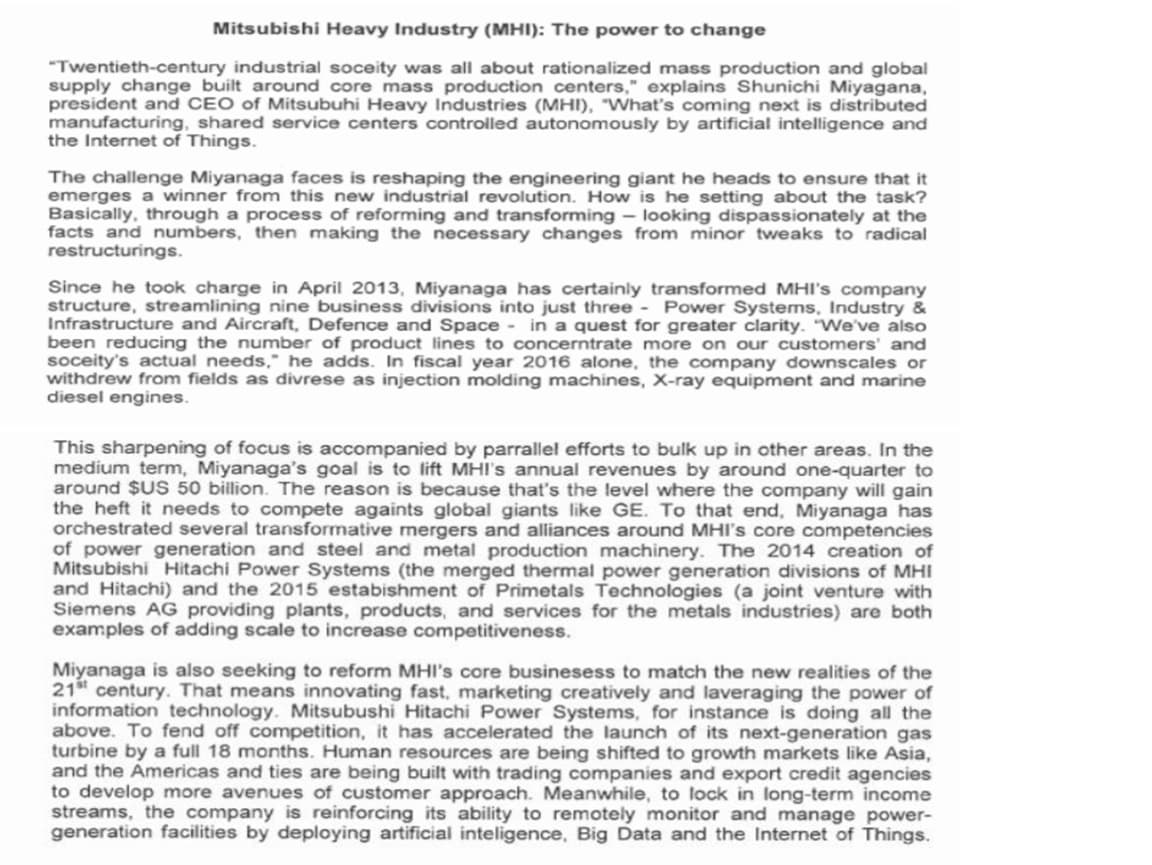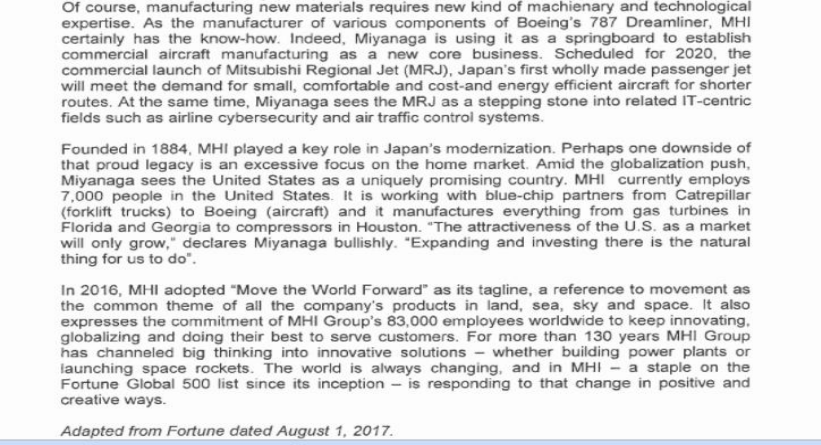Describe TWO weaknesses of MHI Describe FOUR MHI’s strengths that can reduce competitive pressures from its competing rivals and pressures from substitute products
Describe TWO weaknesses of MHI Describe FOUR MHI’s strengths that can reduce competitive pressures from its competing rivals and pressures from substitute products
Chapter1: Taking Risks And Making Profits Within The Dynamic Business Environment
Section: Chapter Questions
Problem 1CE
Related questions
Question
Based on the case study above, answer the following questions:
- Describe TWO weaknesses of MHI
- Describe FOUR MHI’s strengths that can reduce competitive pressures from its competing rivals and pressures from substitute products
Note: Answer need with introduction, explanation, example and conclusion.

Transcribed Image Text:Mitsubishi Heavy Industry (MHI): The power to change
"Twentieth-century industrial soceity was all about rationalized mass production and global
supply change built around core mass production centers," explains Shunichi Miyagana,
president and CEO of Mitsubuhi Heavy Industries (MHI), "What's coming next is distributed
manufacturing, shared service centers controlled autonomously by artificial intelligence and
the Internet of Things.
The challenge Miyanaga faces is reshaping the engineering giant he heads to ensure that it
emerges a winner from this new industrial revolution. How is he setting about the task?
Basically, through a process of reforming and transforming - looking dispassionately at the
facts and numbers, then making the necessary changes from minor tweaks to radical
restructurings.
Since he took charge in April 2013, Miyanaga has certainly transformed MHI's company
structure, streamlining nine business divisions into just three - Power Systems, Industry &
Infrastructure and Aircraft, Defence and Space - in a quest for greater clarity. "We've also
been reducing the number of product lines to concerntrate more on our customers' and
soceity's actual needs," he adds. In fiscal year 2016 alone, the company downscales or
withdrew from fields as divrese as injection molding machines, X-ray equipment and marine
diesel engines.
This sharpening of focus is accompanied by parrallel efforts to bulk up in other areas. In the
medium term, Miyanaga's goal is to lift MHI's annual revenues by around one-quarter to
around $US 50 billion. The reason is because that's the level where the company will gain
the heft it needs to compete againts global giants like GE. To that end, Miyanaga has
orchestrated several transformative mergers and alliances around MHI's core competencies
of power generation and steel and metal production machinery. The 2014 creation of
Mitsubishi Hitachi Power Systems (the merged thermal power generation divisions of MHI
and Hitachi) and the 2015 estabishment of Primetals Technologies (a joint venture with
Siemens AG providing plants, products, and services for the metals industries) are both
examples of adding scale to increase competitiveness.
Miyanaga is also seeking to reform MHI's core businesess to match the new realities of the
21 century. That means innovating fast, marketing creatively and laveraging the power of
information technology. Mitsubushi Hitachi Power Systems, for instance is doing all the
above. To fend off competition, it has accelerated the launch of its next-generation gas
turbine by a full 18 months. Human resources are being shifted to growth markets like Asia,
and the Americas and ties are being built with trading companies and export credit agencies
to develop more avenues of customer approach. Meanwhile, to lock in long-term income
streams, the company is reinforcing its ability to remotely monitor and manage power-
generation facilities by deploying artificial inteligence, Big Data and the Internet of Things.

Transcribed Image Text:Of course, manufacturing new materials requires new kind of machienary and technological
expertise. As the manufacturer of various components of Boeing's 787 Dreamliner, MHI
certainly has the know-how. Indeed, Miyanaga is using it as a springboard to establish
commercial aircraft manufacturing as a new core business. Scheduled for 2020, the
commercial launch of Mitsubishi Regional Jet (MRJ), Japan's first wholly made passenger jet
will meet the demand for small, comfortable and cost-and energy efficient aircraft for shorter
routes. At the same time, Miyanaga sees the MRJ as a stepping stone into related IT-centric
fields such as airline cybersecurity and air traffic control systems.
Founded in 1884, MHI played a key role in Japan's modernization. Perhaps one downside of
that proud legacy is an excessive focus on the home market. Amid the globalization push,
Miyanaga sees the United States as a uniquely promising country. MHI currently employs
7,000 people in the United States. It is working with blue-chip partners from Catrepillar
(forklift trucks) to Boeing (aircraft) and it manufactures everything from gas turbines in
Florida and Georgia to compressors in Houston. "The attractiveness of the U.S. as a market
will only grow," declares Miyanaga bullishly. "Expanding and investing there is the natural
thing for us to do".
In 2016, MHI adopted "Move the World Forward" as its tagline, a reference to movement as
the common theme of all the company's products in land, sea, sky and space. It also
expresses the commitment of MHI Group's 83,000 employees worldwide to keep innovating,
globalizing and doing their best to serve customers. For more than 130 years MHI Group
has channeled big thinking into innovative solutions - whether building power plants or
launching space rockets. The world is always changing, and in MHI - a staple on the
Fortune Global 500 list since its inception - is responding to that change in positive and
creative ways.
Adapted from Fortune dated August 1, 2017.
Expert Solution
This question has been solved!
Explore an expertly crafted, step-by-step solution for a thorough understanding of key concepts.
This is a popular solution!
Trending now
This is a popular solution!
Step by step
Solved in 2 steps

Recommended textbooks for you

Understanding Business
Management
ISBN:
9781259929434
Author:
William Nickels
Publisher:
McGraw-Hill Education

Management (14th Edition)
Management
ISBN:
9780134527604
Author:
Stephen P. Robbins, Mary A. Coulter
Publisher:
PEARSON

Spreadsheet Modeling & Decision Analysis: A Pract…
Management
ISBN:
9781305947412
Author:
Cliff Ragsdale
Publisher:
Cengage Learning

Understanding Business
Management
ISBN:
9781259929434
Author:
William Nickels
Publisher:
McGraw-Hill Education

Management (14th Edition)
Management
ISBN:
9780134527604
Author:
Stephen P. Robbins, Mary A. Coulter
Publisher:
PEARSON

Spreadsheet Modeling & Decision Analysis: A Pract…
Management
ISBN:
9781305947412
Author:
Cliff Ragsdale
Publisher:
Cengage Learning

Management Information Systems: Managing The Digi…
Management
ISBN:
9780135191798
Author:
Kenneth C. Laudon, Jane P. Laudon
Publisher:
PEARSON

Business Essentials (12th Edition) (What's New in…
Management
ISBN:
9780134728391
Author:
Ronald J. Ebert, Ricky W. Griffin
Publisher:
PEARSON

Fundamentals of Management (10th Edition)
Management
ISBN:
9780134237473
Author:
Stephen P. Robbins, Mary A. Coulter, David A. De Cenzo
Publisher:
PEARSON